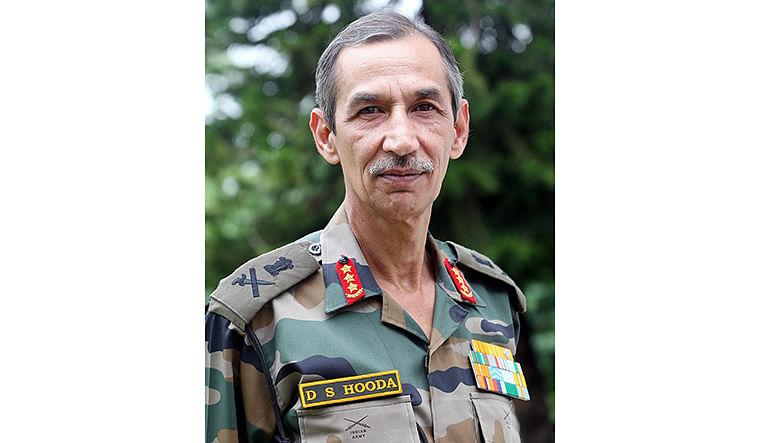
The sudden muscle-flexing by China in Eastern Ladakh has taken the Indian government by surprise forcing the armed forces to put up a formidable defence on the northern border to take on any threats from the Dragon. In his distinguished career spanning over four decades, Lt Gen Deependra Singh Hooda, former General Officer Commanding-in-Chief of the Indian Army’s Northern Command, has seen many facets of China’s People’s Liberation Army. In an interview with DH’s Kalyan Ray, the veteran officer analyses the current crisis. Excerpts:
Q. How the clash at the Galwan Valley that killed 20 Indian soldiers and the Chinese muscle-flexing at Eastern Ladakh is different from regular transgressions by the Chinese patrolling parties?
A. The current situation is completely different from regular transgressions and even the past standoffs at Depsang in 2013, Chumar in 2014, and Dokalam in 2017. One striking variation is the complete
disregard of existing agreements and protocols by the Chinese Army. They have thrown restraint to the wind and deliberately initiated large-scale violence. This would have serious repercussions on the future actions of Indian soldiers, and we are probably going to see a hotter LAC in the future, even if the current crisis is resolved peacefully.
Q. What do you think could be the objective of the PLA (and Chinese government) in opening up a new front at the Galwan Valley and claiming sovereignty?
A. At the Galwan Valley, the PLA wishes to gain a strategic advantage by coming inside our territory to dominate the Darbuk-Shyok-Daulat Beg Oldi (DSDBO) road. This road is absolutely vital for us to support our forces that are deployed in the northern areas of Ladakh leading up to the Karakoram Pass. But I
think there is a larger message that the Chinese are trying to convey that they will use the instrument of military coercion to force an acceptance of their demands. This should force us to reassess our strategy for dealing with China.
Q. The PLA is also heavily increasing its presence on the northern bank of the Pangong Tso – do you think they aim to force a change in the Indian perception of the LAC?
A. To be honest, the PLA has already forced a change in the LAC on the northern bank of the Pangong Tso. Chinese soldiers are currently in physical occupation of areas along with their perception of the LAC
and have constructed numerous posts. The biggest challenge during our negotiations going forward will be to get the Chinese to restore the status quo ante in this area.
Q. What do you think should be the Indian response?
A. Our response must be based on a realistic appraisal of our strengths as well as weaknesses. It will have to be a mix of diplomatic, economic, and military actions. It would be good if political one-upmanship takes a backseat and we all come together
to deal with this grave problem on our hands. While the opposition is questioning every aspect of the handling of this crisis, the ruling party is painting a picture of the PLA having had a free run along the LAC in
the past. Both these narratives do grave injustice to soldiers who are currently handling the difficult
situation as well as those soldiers who have resolutely defended our borders in the past.
Q. You played a key role in planning the surgical strike in the wake of the Uri massacre in which 19 Indian soldiers were killed. This time 20 Indian soldiers including the CO of the unit were killed – do you foresee a similar kind of action?
A. Each situation is different and attempting to apply a Pakistan template to China would not be helpful. We have a strong military capability and the military leaders must professionally present their options to the government, including the implications of escalation. It would obviously be better if the matter is resolved diplomatically, but we must be prepared for all eventualities. After all, in this instance, the Chinese have not hesitated to employ their military forces to change the status quo on the LAC.
Q: Why do you think Indian soldiers did not open a fire when they came under attack though they carried arms (as stated by the Foreign Minister S Jaishankar)? Do you think soldiers really cared about international protocols when they came under attack and saw their CO getting killed?
A. There has already been enough debate on this subject and only the soldiers who were involved in the incident know the true picture and what went through their minds. It is my personal view that if the soldiers were armed, they should have resorted to using their weapons when under attack. No protocols are breached when a person acts in self defence. I think the rules of engagement have now been reviewed and the army has been given freedom to act as it deems appropriate.
Q. Will the physical violence impact the India-China boundary talks?
A. It certainly will. I think the positions on both sides will become hardened and it will become more difficult to find a consensus. The Chinese actions of 15 June, when they tried to set up a post in India territory, and their subsequent statements laying claim over the entire Galwan valley have vitiated the dialogue process. There is now a great deal of suspicion of Chinese intentions. Talks held in the absence of trust face an uphill task.
Q. Should India continue to develop its border infrastructure or will look for a compromise?
A. We are facing a powerful and assertive adversary who now appears willing to use its military capability to forcibly settle the border dispute in its favour. It is, therefore, incumbent on India to strengthen and develop its border infrastructure along with building a robust military. We could see some objections to this from the Chinese side, but we have to stand firm. History teaches us that a policy of appeasement has rarely brought peace to the appeaser.
